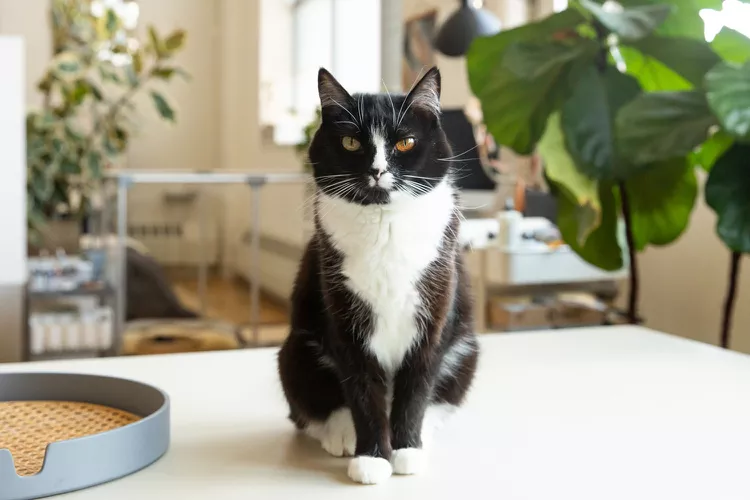Animal Care
Maine Coons Tuxedo Cat: name for tuxedo cat, coffee, stuffed animal, fat, Minecraft and their characteristics.

Maine Coons Tuxedo Cat: name for tuxedo cat, coffee, stuffed animal, fat, Minecraft and their characteristics
Here are some suggestions for names for a tuxedo cat, coffee, stuffed animal, fat, and Minecraft:
The striking black-and-white pattern of tuxedo cats is reminiscent of men’s formal attire. The tuxedo pattern can appear on some purebred and mixed breed cats. Any piebald black-and-white cat is considered to be a tuxedo cat, but the most stunning varieties have a black body with white paws and breast. There are times when a dark spot around the throat even looks like a bow tie!
Tuxedo Cat:
- Shadow
- Oreo
- Domino
- Noir
- Socks
Coffee:
- Java
- Mocha
- Espresso
- Latte
- Cappuccino
Stuffed Animal:
- Snuggles
- Teddy
- Fluffy
- Paws
- Cuddles
Fat:
- Chunk
- Chonk
- Butterball
- Tubby
- Pudge
Minecraft:
- Steve
- Alex
- Creeper
- Enderman
- Zombie
Tuxedo Cat Characteristics
Tuxedo is a coloration pattern that can occur in many different cat breeds. The tuxedo pattern is named after the attire human men wear for formal occasions. Nothing is so dramatic as seeing a “tuxie,” as it is affectionately called, dressed in its best bib and tucker. Some tuxies also wear “spats,” or white boots. This name comes from the word “spatterdash” which is a type of covering that goes over the instep and ankle area of some shoes.
Other variations on the tuxedo theme include a white striped nose and the “masked tuxedo,” with white around the chin and nose or white tips on the nose. Another variation infamously called the “Kitler” features a white “mustache.”
Because many breeds and mixed breeds can sport the tuxedo pattern, the personalities of tuxedo cats vary much more widely than their coloration. The temperament of the individual cat will depend on its genetics and the environment in which it is raised.
History of the Tuxedo Cat
Cats have color genes that can produce the tuxedo pattern in the right combination. Tuxedo cats have the genes to be black. They also have the white spotting gene, which masks the black color on some parts of the body. It does this by preventing the color-producing melanocytes from migrating to those areas. The spotting gene produces different grades of white spotting, from 1 to 10. Tuxedo cats fall into the low grades from 1 to 4. The lower the number, the less white is seen.
No one knows for sure when this gene combination began to be expressed in cats, but it is thought to date back at least to the ancient Egyptians, as bicolor cats have been identified in their tombs. Tuxedo cats appear throughout modern popular culture. Examples of famous bicolored kitties include:
- Felix the Cat was a character created during the 1920s silent film era. Felix was featured in cartoons, animation, and assorted merchandise. Even today the Felix clock, with its long black tail wagging back and forth, is a favorite cat collectible.
- In T.S. Eliot’s 1939 book of poems, Old Possum’s Book of Practical Cats, a group of nocturnal black-and-white cats were referred to as “Jellical” cats.
- Sylvester the Cat, of Looney Tunes, is another famous tuxedo cat. Sylvester has white jowls, a long bib extending down his belly, white feet, and a white tip on his tail.
- “The Cat in the Hat” by Dr. Seuss, published in 1957, also featured a talking tuxedo cat.
- Socks, known as the First Cat during the Bill Clinton White House administration, was a famous real-life tuxedo cat.
Tuxedo Cat Care
The individualized care of a tuxedo cat will depend on its breed. Its coat requires no special treatment based on color pattern. Brushing your cat will help reduce matting and may help prevent hairballs. Trim your cat’s nails every two to three weeks and provide a scratching post. Also, as with any cat, stay up-to-date on veterinary visits and vaccinations to help prevent health problems.
Give your cat plenty of chances to play and chase toys, and offer safe places to retreat. Cats like lots of sleep and cat naps, so provide a comfortable bed and other places around your living area where your cat can lounge.
Indoor cats will need a litter box in a quiet area. Be sure to completely dump and clean the box at least once a week. Using clumping litter and scooping out the clumps daily can keep things tidy.















